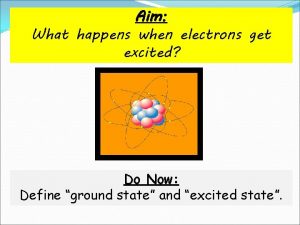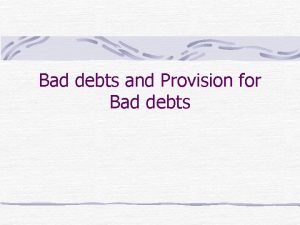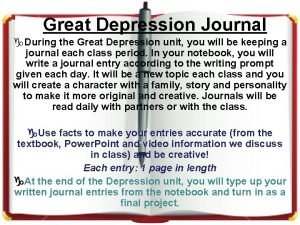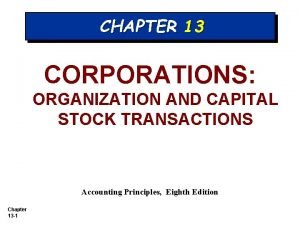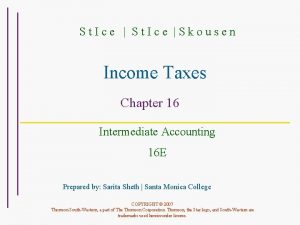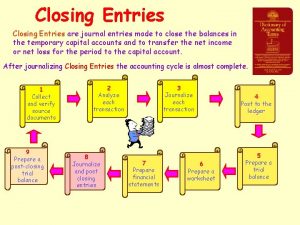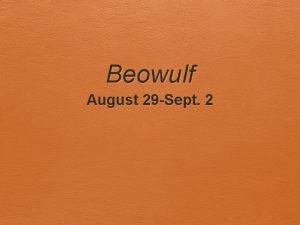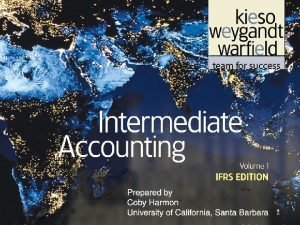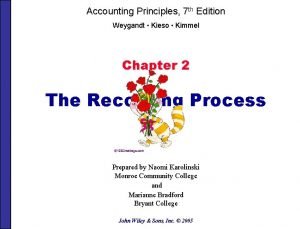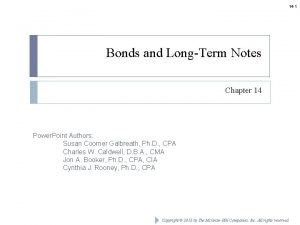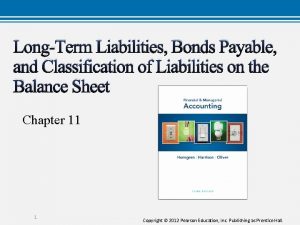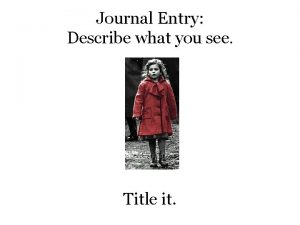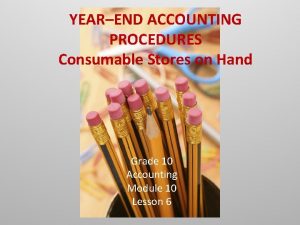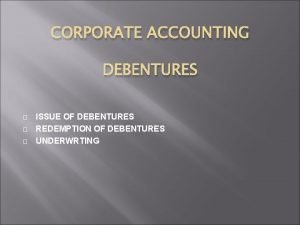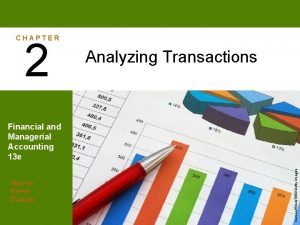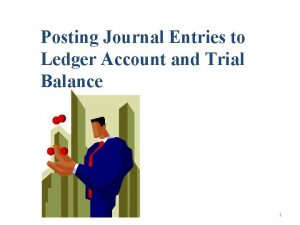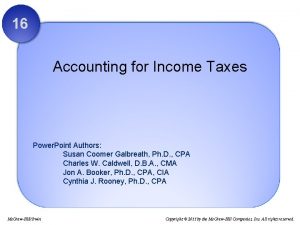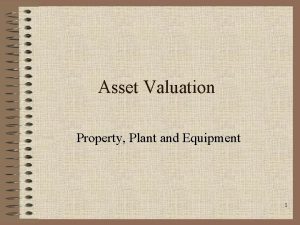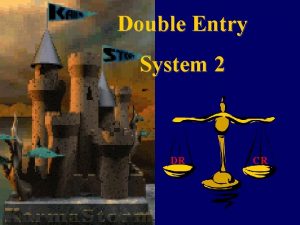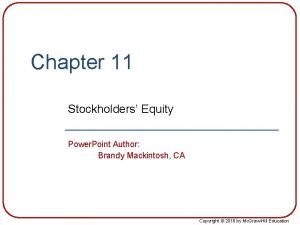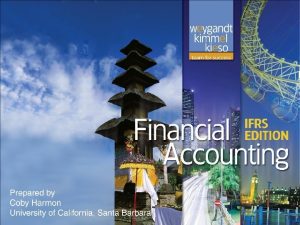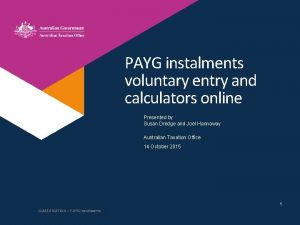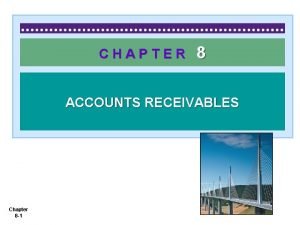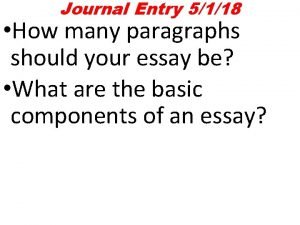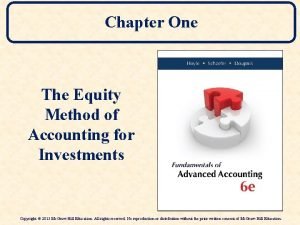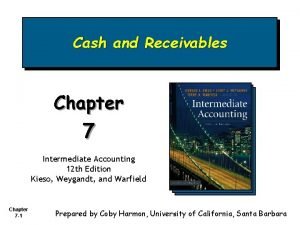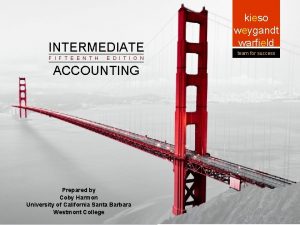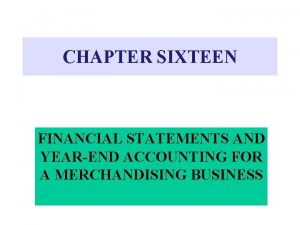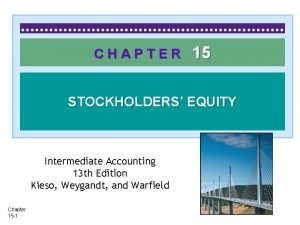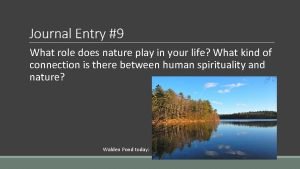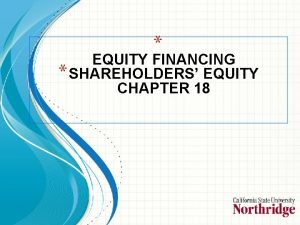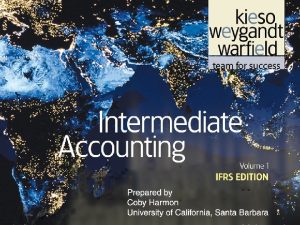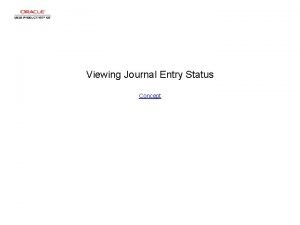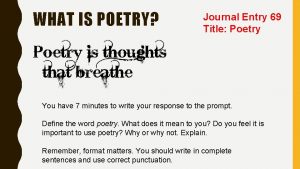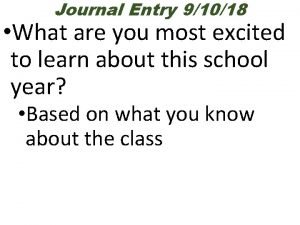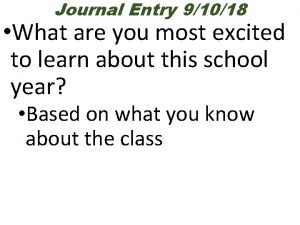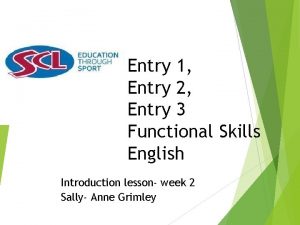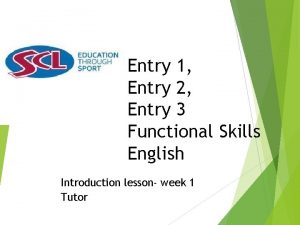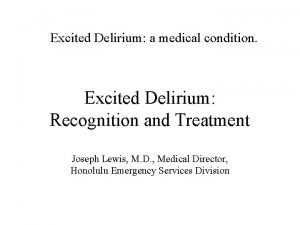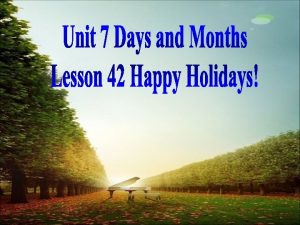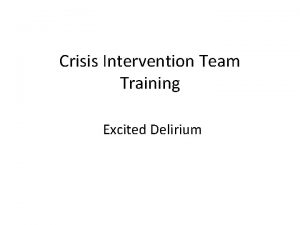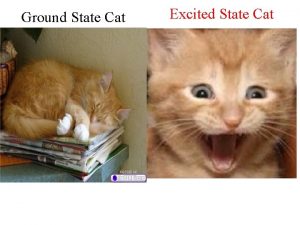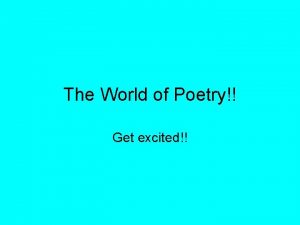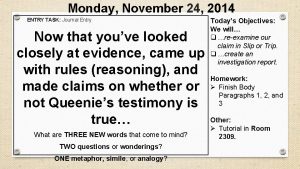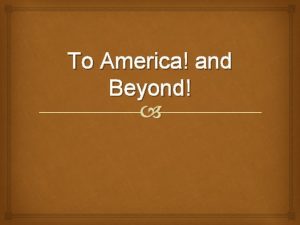Introducing Poetry Get Excited Journal Entry 13 Poetry














































- Slides: 46

Introducing Poetry Get Excited!!!

Journal Entry #13: “Poetry Begins…” – 2. 2. 15 Copy and address ONE of the following quotes with TWO RESPOND prompts. “Poetry has two outstanding characteristics. One is that it is undefinable. The other is that it is eventually unmistakable. ” – Edwin Arlington Robinson “Every good poem begins as the poet’s but ends as the reader’s. ” – Miller Williams

Approaching Poetry Rule #1: Be more concerned with responding to poetry than defining poetry. - Note: this response does not have to be intellectual. In fact, emotional responses to poetry can be just as (and even more) valid as logical or intellectual responses.

Approaching Poetry Rule #2: Slow down. - Never forget that good poetry is often very dense. So while you can probably make some sense of (and take some enjoyment from) a poem the first time you read it, in order to fully understand appreciate most good poetry, you must read it closely and with careful attention. This requires you to SLOW DOWN your reading.

Approaching Poetry Rule #3: Read out loud. - Unlike most prose, poetry is intended to be read aloud. Poetic elements such as assonance, consonance, and alliteration are distinctly poetic for their audible qualities – because you can hear them.

Review of Poetic Elements Here are the major poetic elements that we covered last unit: • Sensory Imagery • Repetition • Rhyme – Perfect Rhyme – Alliteration – Consonance – Assonance

Sensory Imagery 1) The term imagery signifies all of the sensory perceptions – not just sight/visual. ( e. g. , sound, touch, taste, and smell) 2) Sensory imagery is not relegated to literal description exclusively – it can also be executed using figurative language (e. g. metaphor, simile, allusion, etc. )

Repetition is an effective literary device that may bring comfort, suggest order, or add special meaning to a piece of literature

Perfect Rhyme Two conditions must be met in order for a rhyme to be perfect: 1) the vowel sound in both words must be identical: (sky and high; plate and eight) 2) the sounds before those vowel sounds must differ: (green and machine) –NOT– (leave and believe)

Alliteration - the repetition of consonant sounds that appear at the beginnings (or near the beginnings) of nearby words Example: Pride and Prejudice

Consonance - is the repetition of consonant sounds in two or more successive words (or stressed syllables) (1) the two words (or syllables) contain different vowel sounds (2) the repetition doesn’t usually come at the beginnings of words (that would be alliteration) Examples: had/hid; uncertain/rustling; rabies/rabbit

Assonance - the repetition of identical or similar vowel sounds in two or more successive words (or stressed syllables). Examples: solitude/musings; quest/felt; agree/either; daddy/jag/batting/practice

Our Approach to Poetry There are many different approaches to interpreting poetry – though it is best when you combine approaches and interpret it through multiple lenses. We will be examining poetry through three different lenses: • poetic forms • poetic genres • poetic movements

Overview (of Poetic Forms) • • For this unit on poetry, we will be studying seven poetic forms: the haiku the tanka the limerick the sonnet (Italian) the sonnet (English) the villanelle open form

Interpreting Poetry through Poetic Form One good starting point for understanding poetry is through the lens of poetic form. Poetic form refers to the various rules a poem follows. These rules typically refer to the poem’s length, structure, rhyme scheme, meter, and so forth.

The Form of the Haiku three lines in length 5 -7 -5 syllable count (17 syllables total) uses strong, nature-based imagery contains a kireji or “cutting word” – a hitch, or leap, or turning point – that takes the reader from one (small/local) idea or element to another (cosmic/spiritual) idea or element, which is meant to lead the reader to a moment of insight, or satori • uses a kigo – a word or phrase that suggests the time of year (i. e. , the season) • •

The Form of the Tanka five lines in length 5 -7 -7 syllable count (31 syllables total) (5 -7 -5) = kami-no-ku or “upper phrase” (7 -7) = shimo-no-ku or “lower phrase” employs a kireji (“cutting word”) in the third line, separating the kami-no-ku from the shimo-no-ku • while, like the haiku, the tanka can be nature-based, historically it uses love as the subject matter – more specifically, hidden love between secret lovers • unlike the haiku, with grand, cosmic insight, the tanka more concerns itself with expressing profound feelings • • •

The Form of the Limerick five lines in length follows an a-a-b-b-a rhyme scheme lines 1, 2, and 5 share a longer metrical length lines 3 and 4 share a shorter metrical length humorous and bawdy in tone – often bordering on inappropriate but coded to the point of reading nearly nonsensical • subject matter often centers around a specific person or place • easily identified by its signature sing-song nature • • •

Warm Up – 2. 5. 15 Take out your poems from yesterday. Spend 5 -7 minutes finishing your haiku, tanka, and/or limerick.

The Form of the (Italian) Sonnet • Also known as the Renaissance or Petrarchan Sonnet • fourteen lines in length • divides into two parts: – the octave (abba-abba) – the sestet (cde-cde); (cdc-dcd); or (cdc-cdc) • these two rhyme schemes represent two parts of the poem: – the octave = the problem – the sestet = (varies) the solution; reinterpreting the problem; repositioning the problem ironically; etc. - This divide = the turn (Italian = volta)

The Form of the (English) Sonnet • Also known as the Shakespearean Sonnet • fourteen lines in length • follows the following end-rhyme scheme: – a-b-a-b, c-d-c-d, e-f-e-f, gg - gg = a couplet, which is a pair of lines that share the same rhyme and meter • while each of the four sections can represent a change or turn, the most profound volta occurs in the couplet at the very end • subject matter most often centers around love – love of the deep, passionate, romantic type (think: Romeo and Juliet)

The Form of the Villanelle • nineteen lines in length • divides into six parts: – first five parts are tercets = stanzas of three lines – last part is a quatrain = stanza of four lines • uses an intricate pattern with two running rhyme schemes and two refrains • due to the nature of the form, the subject matter often centers around cycles, recurrence, and mental maladies such as alienation, paranoia, and, most often, obsession • due to the nature of the form, the villanelle often refuses narratives and conversational tones

The Mimic Poem - The writer is purposely influenced by an established poet. - Writing this type of poem is an exercise in copying the rhythm, language, style or subject of another poem. - The purpose of creating a mimic poem is to consider all the elements that combine to create a memorable work. - Done often enough, a poet might be able to incorporate a specific trait admired in a classic work.

Open Form Poetry • also called free verse • poetry that does not follow a predetermined set of rules regarding length, structure, rhyme scheme, meter, etc. • relies on an intense use of language to establish its relations between meaning and form • sets to discover/present a fresh and individual arrangement of words • sometimes regarded as being the most difficult type of poetry to compose

Overview (of Poetic Genres) • • • In addition to studying poetry through forms, we will also consider poetry through the lens of genres. The five major genres of poetry we will study are: the elegy the ode ekphrasis found poetry spoken word poetry

Interpreting Poetry through Poetic Genres Where poetic form is more concerned with the internal, technical aspects of the poem (e. g. , meter, rhyme scheme, et cetera), poetic genre is often far more interested in the external function of the poem as a social tool. Forms = guided by and in response to poetics Genres = guided by and in response to environment

The Elegy • paramount to the history and tradition of poetry (especially as a social endeavor) • a lament; depicts loss; mourns the dead; praises the virtues of the dead; seeks consolation • coauthored – inspired by someone or something communal – expresses a type of cultural grief beyond the poet • the great balance – deep internal grief and polished external decorum – private feeling and public service

The Ode • also paramount to the history and tradition of poetry • an elevation or glorification of a person, object, or occasion that is of great interest or inspiration to the poet • full of flatteries, exaggerations, and claims of excellence and high standing of the subject • while the irregular ode has no set poetic rules, it generally consists of at least three stanzas and adheres to maintaining equal rhyme schemes and line lengths between those stanzas

Ekphrasis • essentially, ekphrasis is one medium of art relating to another medium of art by defining and describing its essence and form • for our purposes: a graphic, dramatic, poetic description of a visual work of art (e. g. a famous painting, an acclaimed photograph) • very much a competition between the visual and the written forms – with each complimenting the other to create a more dynamic representation

Pieter Bruegel’s Landscape with the Fall of Icarus

Edward Hopper’s Nighthawks (1942)

Found Poetry • derived from the philosophy of “Ready-made” or “Found Object” art, which emphasizes the notion that art is found in the eye of the artist • raises deep, philosophical questions about the nature of art, the artist, society, and beauty • Found Poetry is a type of poetry created by taking words, phrases, and sometimes whole passages from other sources and reframing them • this is executed by making changes in spacing and lines, deleting (sometimes adding) text, and purposefully decorating the medium/form

Found Poetry as “Readymade” art Marcel Duchamp’s Fountain (1917)

“Ready-made” Art (continued) Tracey Emin’s My Bed (1999)

Examples of Found Poetry




Spoken Word Poetry • best understood as performance poetry • an open form (though “slam” competitions limit pieces to three minutes in length, and forbid the use of any external props or assistance) • more intended to be heard rather than read • relies more heavily on the audible aspects of poetry such as: – concrete sensory imagery – rhyme – repetition

On the Performance Aspect of Poetry Tips for the oral presentation of poetry (the three V’s): • Voice – total commitment to what you are saying • if you don’t believe it, we never will • Volume – you must reach everyone in the room • you should sound way too loud to yourself – enunciate • be sure to practice carefully pronouncing each syllable slowly and clearly – breathe • Vigor • remember to practice your breathing and where you take pauses/stops for breaths – always remember that you are performing • give the piece life through grand entrances and exits, appropriate postures, steady eye contact, and engaging facial expressions and body gestures

Overview (of Poetic Movements) In addition to poetic forms and poetic genres, we will also consider poetry through the lens of poetic movements. The four movements of poetry we will examine are as follows: • Confessional Poetry (1950 -1980) • Imagist Poetry (1900 -1930) • Harlem Renaissance Poetry (1915 -1930)

Interpreting Poetry through Poetic Movements As we have discovered, understanding poetic forms and poetic genres can help us to better understand the meaning of and power behind individual poems. Understanding poetic movements can do the same. Poetic movements arise when a group of poets, of the same era, write about similar things and in a similar way. Please note: new movements generally develop in opposition to (and as a direct response to) the things and the ways of the generations and movements preceding them.

Confessional Poetry • originated some time in the early 1950’s and lasted into the 1980’s • described as the “poetry of the personal” – emphasized issues pertaining to the individual poet • very controversial during its time, for presenting what was regarded as very taboo subject matters such as, sexuality (homosexuality, promiscuousness, et cetera), mental illness, suicide, and things of this nature • prominent figures include, Robert Lowell, John Berryman, Anne Sexton, Sharon Olds, Allen Ginsburg, and Sylvia Plath

Harlem Renaissance Poetry • originated just before 1920 and extended into the 1930’s • originally known as the “New Negro Movement, ” it championed African-American cultural expression in urban areas • served as a direct response to the Great Migration of the early 20 th century • eventually serving as a catalyst for the Civil Rights Movement • key characteristics include: – overt pride in heritage (meant to uplift) – promoting consciousness (for both said group and outside groups) – socially and politically charged (designed to inspire change) • prominent figures include Zora Neale Hurston, James Baldwin, Claude Mc. Kay, Countee Cullen, and Langston Hughes

Imagist Poetry • important branch of Modernism that originated in the early 1900’s and lasted into the 1930’s • aims to get at essence by simply capturing a singular thing at a singular moment • implies themes; does not explicitly state themes • very economical language (no extra words) • prominent figures include T. E. Hulme, D. H. Lawrence, Amy Lowell, William Carlos Williams, Hilda Doolittle, and Ezra Pound

Beat Poetry • also referred to as “Beatnik” poetry (poets called “Beatniks”) • originated some time in the late 1940’s and extended into the 1960’s (where it morphed into the hippies of the counterculture movement) • signature motif is a brash sense of liberalism, encouraging a liberation from: – – legal restrictions (i. e. , drug usage, censorship, etc. ) sexuality (i. e. , bi-sexuality, swinging, etc. ) religion (i. e. , Eastern theologies, mysticism, etc. ) artistic labels (i. e. , legitimate rock & roll, open form, etc. ) • also very controversial during its time, sparking one of the most important censorship trials in American history • prominent figures include, William S. Burroughs, Jack Kerouac, Gregory Corso, and Allen Ginsburg
 Get on get off get into get out of
Get on get off get into get out of One direction song one thing
One direction song one thing Excited state of neon
Excited state of neon The most helpful classmates are the ones who
The most helpful classmates are the ones who Excited to get started
Excited to get started Provision for bad debts in trial balance
Provision for bad debts in trial balance Great depression journal entry
Great depression journal entry Capital stock
Capital stock Deferred tax asset journal entry
Deferred tax asset journal entry Journal entries in the books of hire purchase
Journal entries in the books of hire purchase Recording closing entries
Recording closing entries Beowulf double entry journal answers
Beowulf double entry journal answers Impairment and depreciation difference
Impairment and depreciation difference Aet journal entry
Aet journal entry Withdraw cash for personal use journal entry
Withdraw cash for personal use journal entry Bonds with detachable warrants journal entry
Bonds with detachable warrants journal entry Long-term notes payable
Long-term notes payable What does this journal entry describe
What does this journal entry describe What type of account is consumable stores on hand
What type of account is consumable stores on hand Journal entry for underwriting commission
Journal entry for underwriting commission Horizontal analysis example
Horizontal analysis example Perpetual review system
Perpetual review system Journal entry and ledger posting
Journal entry and ledger posting Written down value method
Written down value method Deferred tax asset journal entry
Deferred tax asset journal entry Property plant and equipment
Property plant and equipment Discount allowed meaning
Discount allowed meaning Average owner's equity formula
Average owner's equity formula Journal entry for revaluation of assets
Journal entry for revaluation of assets Payg instalment payable journal entry
Payg instalment payable journal entry Accounts receivable journal entry
Accounts receivable journal entry Closing stock formula
Closing stock formula If a child washes his hands, he could eat with kings.
If a child washes his hands, he could eat with kings. How many paragraphs is a journal entry
How many paragraphs is a journal entry Journal entry for equity
Journal entry for equity Payroll accounting entries
Payroll accounting entries Double journal entry template
Double journal entry template Notes receivable journal entry
Notes receivable journal entry Accrued expenses are
Accrued expenses are Security audit training
Security audit training Tax liability definition
Tax liability definition Account title
Account title Chapter 15 intermediate accounting
Chapter 15 intermediate accounting Nature journal entry
Nature journal entry Large stock dividend journal entry
Large stock dividend journal entry How to record contingent liabilities
How to record contingent liabilities How to calculate pension expense
How to calculate pension expense


